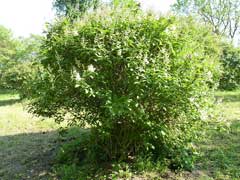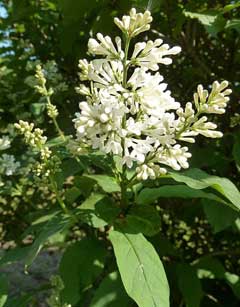 |
|
http://commons.wikimedia.org/wiki/User:Aroche |
 |
| http://commons.wikimedia.org/wiki/User:Aroche |
Translate this page:
Summary
Bloom Color: Purple. Main Bloom Time: Late spring. Form: Rounded, Vase.
Physical Characteristics

 Syringa josikaea is a deciduous Shrub growing to 4 m (13ft 1in) at a medium rate.
Syringa josikaea is a deciduous Shrub growing to 4 m (13ft 1in) at a medium rate.
See above for USDA hardiness. It is hardy to UK zone 5. It is in flower in June. The species is hermaphrodite (has both male and female organs) and is pollinated by Insects.
Suitable for: light (sandy), medium (loamy) and heavy (clay) soils and prefers well-drained soil. Suitable pH: neutral and basic (mildly alkaline) soils and can grow in very alkaline soils.
It cannot grow in the shade. It prefers moist soil.
UK Hardiness Map
US Hardiness Map
Synonyms
Plant Habitats
Woodland Garden Sunny Edge; Dappled Shade; Hedge;
Edible Uses
References More on Edible Uses
Medicinal Uses
Plants For A Future can not take any responsibility for any adverse effects from the use of plants. Always seek advice from a professional before using a plant medicinally.
None known
References More on Medicinal Uses
The Bookshop: Edible Plant Books
Our Latest books on Perennial Plants For Food Forests and Permaculture Gardens in paperback or digital formats.

Edible Tropical Plants
Food Forest Plants for Hotter Conditions: 250+ Plants For Tropical Food Forests & Permaculture Gardens.
More

Edible Temperate Plants
Plants for Your Food Forest: 500 Plants for Temperate Food Forests & Permaculture Gardens.
More

More Books
PFAF have eight books available in paperback and digital formats. Browse the shop for more information.
Shop Now
Other Uses
References More on Other Uses
Cultivation details
Landscape Uses:Specimen. Succeeds in any fertile well-drained neutral to alkaline soil, preferring a position in full sunshine[182, 200]. Thrives in chalky soils[182]. Plants in this genus are notably susceptible to honey fungus[200]. Special Features:Not North American native, Fragrant flowers, Blooms are very showy.
References Carbon Farming Information and Carbon Sequestration Information
Temperature Converter
Type a value in the Celsius field to convert the value to Fahrenheit:
Fahrenheit:
The PFAF Bookshop
Plants For A Future have a number of books available in paperback and digital form. Book titles include Edible Plants, Edible Perennials, Edible Trees,Edible Shrubs, Woodland Gardening, and Temperate Food Forest Plants. Our new book is Food Forest Plants For Hotter Conditions (Tropical and Sub-Tropical).
Shop Now
Plant Propagation
Seed - sow March in a north facing cold frame. Pre-treating the seed with 4 weeks warm then 3 weeks cold stratification improves germination. It is probable that sowing the seed as soon as it is ripe in a cold frame would be a more reliable method[K]. Prick the seedlings out into individual pots once they are large enough to handle. Plant them out in the summer if sufficient growth has been made, otherwise grow them on in a cold frame for their first winter and plant out in late spring of the following year. Cuttings of young shoots, 7cm with a heel, June in a frame[200]. Cuttings of half-ripe wood, 7cm with a heel, July/August in a frame[200]. Layering in spring before new growth begins. Takes 12 months[78]. Division of suckers in late winter. They can be planted straight out into their permanent positions.
Other Names
If available other names are mentioned here
Native Range
EUROPE: Ukraine, Romania
Weed Potential
Right plant wrong place. We are currently updating this section.
Please note that a plant may be invasive in one area but may not in your area so it's worth checking.
Conservation Status
IUCN Red List of Threatened Plants Status :

Growth: S = slow M = medium F = fast. Soil: L = light (sandy) M = medium H = heavy (clay). pH: A = acid N = neutral B = basic (alkaline). Shade: F = full shade S = semi-shade N = no shade. Moisture: D = dry M = Moist We = wet Wa = water.
Now available:
Food Forest Plants for Mediterranean Conditions
350+ Perennial Plants For Mediterranean and Drier Food Forests and Permaculture Gardens.
[Paperback and eBook]
This is the third in Plants For A Future's series of plant guides for food forests tailored to
specific climate zones. Following volumes on temperate and tropical ecosystems, this book focuses
on species suited to Mediterranean conditions—regions with hot, dry summers and cool, wet winters,
often facing the added challenge of climate change.
Read More
Expert comment
Author
Jacq.f. ex Rchb.
Botanical References
11200
Links / References
For a list of references used on this page please go here
Readers comment
| Add a comment |
|
If you have important information about this plant that may help other users please add a comment or link below. Only comments or links that are felt to be directly relevant to a plant will be included. If you think a comment/link or information contained on this page is inaccurate or misleading we would welcome your feedback at [email protected]. If you have questions about a plant please use the Forum on this website as we do not have the resources to answer questions ourselves.
* Please note: the comments by website users are not necessarily those held by PFAF and may give misleading or inaccurate information.
To leave a comment please Register or login here All comments need to be approved so will not appear immediately.
|
Subject : Syringa josikaea
|
|
|
|